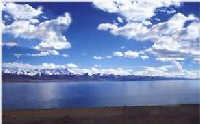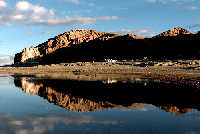|
Namtso Lake
( 2005-10-14 )
 Best time to go: Summer or on Tibet New Year, because Thousands of pilgrims travel a long way to worship here on the Tibetan New Year. Best time to go: Summer or on Tibet New Year, because Thousands of pilgrims travel a long way to worship here on the Tibetan New Year.
TheNamtso Lakeis held as "theheavenly lake" or "the holy lake" in northern Tibet. Lying at the foot of Nyainqentanglha Mountain, it covers an area of 1,940 square kilometers at an elevation of 4,718 meters. It is believed to be the second largest saltwater lake in China and the saltwater lake at the highest elevation in the world.
Respected as one of the three holiest lakes in Tibet, the Namtso Lake is the seat of Paramasukha Chakrasamvara for Buddhist pilgrims. In the fifth and sixth month of the Tibetan calendar each year, many Buddhists come to the lake pay homage and pray. Deep tracks are worn into the lakeshore due to this activity. In history, monasteries stood like trees in a forest around the site, attracting large numbers of pilgrims as eminent monks in Buddhisttemples extended Buddhist teachings.
Buddhists believe Buddhas, Bodhisattvas and Vajras will assemble to hold religious meeting at Namtso in the year of sheep on Tibetan calendar. It is said that walking around the lake at the right moment is 100,000 times more efficacious than that in normal years. That's why thousands of pilgrims from every corner of the world come to pray at the site, with the activity reaching a climax on Tibetan April 15.
Walking around the lake takes a week. Ritual walkers love to burn aromatic plants to raise smoke on Auspicious Island [explain this a little] and throw a piece ofhadascarf into the lake as a token of fulfilled wishes. If the scarf sinks, it implies ones wish is accepted by the Buddha; if the scarf flows on the water or only half sinks, it means one has failed to be honest and something unhappy may lie ahead.
On the four sides of the lake stand four monasteries, which have Buddhist meanings. By the lake there are also two standing stone pillars, each rising 30 meters and eight meters apart. One has a crack large enough to hold a single person inside. Some Tibetans believe it is the Gate God of the Namtso Lake.
 Five islets planted in the vast sapphire lake are said to be the incarnation of the Buddha of Five Directions. Every pilgrim walking around the lake will piously worship them. These islets are famous for their topography, covered by weird but vivid stones. Five islets planted in the vast sapphire lake are said to be the incarnation of the Buddha of Five Directions. Every pilgrim walking around the lake will piously worship them. These islets are famous for their topography, covered by weird but vivid stones.
Another five peninsula protrude into the lake and represent sites related to eminent monks, such as temples. On the north bank of the lake is the Zhaxi Peninsula, on which stands a forest of strange-shaped stones forged from calcium, among which occur numerous fantastic caves.
Besides gorgeous and enchanting sights, the Namtso Lake is also rich, with birds darting over the water now and then. It is a heaven for animals and plants, producing abundant fish. The natural pastureland around the lake offers ideal conditions for animal husbandry.
The views around Lake Namtso each evening at dusk are beautiful and fantastic.
|

